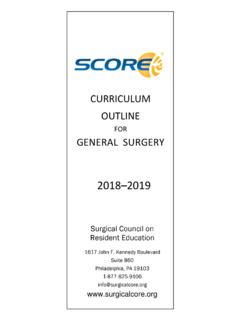Transcription of Diagnosis and Treatment of Pancreas Tumours - BC Cancer
1 Diagnosis and Treatment of Pancreas Tumours Alice C. Wei, MD, MSc, FRCSC, FACS Princess Margaret Cancer Centre HPB Surgical Oncology and General Surgery Associate Professor of Surgery, University of Toronto Lead, Quality and KT, Surgical Oncology, Cancer Care Ontario BC Surgical Oncology Network, Oct 22 2016 2 CONFLICT OF INTEREST DECLARATION I, Alice Wei declare that in the past 3 years: I have been a member of an Advisory Board or equivalent with the following companies*: Ethicon, Histosonic, Celgene, Sanofi, Takeda, Bayer I have been a member of the following speakers bureau: None I have done speaking engagements for the following companies*: Sanofi, Celgene I have received payment or funding from the following companies* (includes gifts, grants, honoraria, and in kind compensation): None I have done consulting work for the following companies*: Cancer Care Ontario I have held a patent for a product referred to in the program or that is marketed by a commercial organization: None I or my family hold individual shares in the following companies*: None I have participated in a clinical trial for the following companies*.
2 None MANAGING POTENTIAL BIAS no commercial uses will be discussed *pharmaceutical, medical device, or communications companies 3 Learning Objectives Learn about the incidence of common pancreatic lesions Review the Diagnosis and management of Pancreas masses 4 Question: Pancreatic lesions lesions are uncommon and decreasing in frequency cystic lesions rarely require surgery cystic neoplasms require surgery for high risk features pancreatic lesions usually require surgery duct IPMNs can be followed if < 3 cm 5 Pancreatic lesions pathology is common pancreatitis 5-10/10000 pancreatic Cancer 4th most common cause of Cancer death 4600 cases yearly pancreatic cystic lesions detection of lesion increasing 6 Diagnosis of pancreatic lesions many are incidental ~ 50% of pancreatic referrals 48% are solid 25% require resection found in work
3 Up of GU symptoms (16%) LFT abnormality (13%) screening (7%) or chest pain(6%) When symptoms present Pancreatitis, abdominal pain, jaundice Weight loss, fatigue 7 Approach to pancreatic lesions History and physical history of pancreatitis or CBD stones? history of Pancreas Cancer ? Symptoms? Imaging essential US CT MRI Eus /Biopsy 8 Ultrasound Safe, inexpensive sensitivity is 88% for solid lesions surveillance of established lesions appropriate screening test Disadvantages Quality is operator dependent visualization is limited for: fatty livers obese patients gas overlying the Pancreas simple unilocular cyst microcystic serous cystadenoma 9 CT scan Contrast enhanced CT most useful excellent anatomic resolution defines relationship between lesion and vascular structures distant/peritoneal disease use Pancreas dedicated protocol Arterial/venous phases with coronal/ sagittal views thin slices through the Pancreas Pancreas adenocarcinoma pseudocyst 10 MRI scan excellent for CYSTIC lesions Good adjunct to CT for indeterminate lesions Addition of gadolinium of primovist contrast helpful for indeterminate
4 Liver lesions MRCP confirm cystic nature of lesion assess biliary and pancreatic ducts relationship of lesion to ducts simple unilocular cyst IPMN 11 When to biopsy Only when tissue needed to guide Rx to confirm malignancy Cyst fluid analysis EUS preferred when surgery is an option Biopsy metastases if present liver biopsy n easier confirms stage and malignancy 12 Pancreas lesions adenocarcinoma Serous cystic neoplasm neuroendocrine 13 Cystic Lesions of Pancreas Incidence: Autopsy Series 25% MRI Series 20% Evolving knowledge: Histopathology/classifications Clinical significance Management pseudocyst Large IPMN 14 Cystic Lesions of Pancreas Common Pseudocyst Serous Cystadenoma Mucinous Cystadenoma IPMN Uncommon Solid/pseudopapillary epitheliod neoplasm (SPEN) Cystic neuroendocrine Cystic Adenocarcinoma Metastases Simple pancreatic cyst Lymphoepithelial cyst Hydatid cyst Mucinous non-cystic tumor Osteoclast like-giant cell 15 Pseudocyst Most common cystic lesion (85%) history of pancreatitis common majority are asymptomatic Symptoms if present Pain, mass effect Bleeding, Infection Rx.
5 Asymptomatic observation Symptoms drainage Endoscopic percutaneous surgical pseudocyst 16 Serous cystic neoplasm Serous cystic neoplasm Median age: 60 years 75% female Median size: 5 cm 65% located in the body and tail Usually solitary well circumscribed Honeycomb-like structure < 1% malignant transformation Rx: Surveillance 17 Mucinous cystic neoplasm mucinous cystic neoplasm Thick walled septated cysts Median age: 50 years ~75% female Usually multilocular NO communication with duct ~ 90% in body/tail 18%-48% malignant transformation Older age, wall calcifications, size, CEA at risk for Cancer Rx.
6 Surgical Excision If Cancer 5-year OS ~60% 18 Main Duct IPMN Side-Branch IPMN Combined IPMN IPMN Incidence with age Male > Female Benign or low grade malignancy 3 variants main duct side branch combined/mixed type fish mouth ampulla Intraductal Papillary Mucinous Neoplasm 19 Presentation depends on morphology Asymptomatic side branch Pancreatitis main/combined type malignancy1 with High risk stigmata Worrisome features if malignant pancreatic adenocarcinoma Surgery to PREVENT malignancy Intraductal Papillary Mucinous Neoplasm main type IPMN combined type IPMN 1.
7 Tanaka M, Pancreatology, 2012 20 Proportion of malignant IPMN at UHN (2000-2012) IPMN defined in 2004 by Hruban RH (Wei et al Manuscript in preparation) 21 Fukuoka algorithm for IPMN (2012) 1. Tanaka M, Pancreatology, 2012 22 Solid pseudopapillary epithelial neoplasm (SPEN) Rare, 90% in young woman peak incidence 3rd decade Asian and African predilection majority are benign (85%) arise from unknown cell of origin Rx: surgical resection SPEN 23 Simple pancreatic cysts not very common sporadic usually isolated familial or syndromic variants PCKD, VHL Natural history not clear Rx: recommend lifelong surveillance interval?
8 6-24 months? Simple cyst 24 Management of pancreatic cystic neoplasms CT / MRI-MRCP / EUS Specificity: 90-95% Serous Cystadenoma Mucinous Cystadenoma IPMN Symptomatic or > 4 cm Asymptomatic or < 4 cm consider Surgical Resection Observation Surgical Resection Main Duct Branch Duct Surgical Resection No worrisome features Worrisome features Observation High risk stigmata Worrisome features? Surgical Resection 25 Classification of solid pancreatic lesions Primary Pancreatic Lesions Benign Chronic Pancreatitis Auto-immune Pancreatitis Pseudo Tumors Potentially Malignant Serous / Mucinous Cystadenomas Malignant IPMN Duct Branch Exocrine Tumors Endocrine Tumors Accessory Spleen Hamartomas Hyperplasia of the Ampulla of Vater Pseudolymphoma Granulomatous Inflammation (Sarcoidosis / Tubercolosis) Primary Secondary 10% of pancreatic masses 90% of pancreatic masses 26 Pancreatic up next 27 Toronto General Hospital Princess Margaret Hospital











